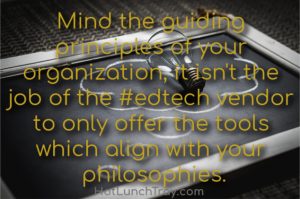Educational Technology is a big business. And every vendor wants to sell you. It is your job to keep in mind the guiding principles of your organization (classroom, school, district) – not the job of the #edtech vendor to only offer the tools which align with your philosophies. You need a big idea.
Without a well-defined guiding principle, such as Blended Learning, you are likely to fall into common traps.

Aimless
You need a big idea that tools and strategies plug into – or don’t plug into – to guide your purchasing and direction as a classroom/school/district.
Insist on articulating this with those in charge of purchasing in advance of meeting with any vendor. You do not want the purchase to turn how persuasive, informed, how likable a vendor is. You need objectives that a product meets or does not meet.
This calls for the inclusion of content and instructional specialists in all #edtech purchases – from the inception of the need. Not as a final group to approve from pre-selected vendors.
Recency
The trap of technology recency is the result of no larger guiding principle. Once technology integration is the definition, you must continue to purchase the most recent tools to remain relevant. An ideal situation for the #edtech vendor, a nightmare for any educational budget.
#edTech is not an idea; #edtech is a means to an end. Without a destination, your path is on-going, never-ending. No benchmarks or progress toward a destination can be marked without a goal to reach.
Return on Investment
The idea of Return on Investment is often a “dollars in” to “dollars out” ratio in the business world. In the educational world, the dollars in are still very real however the output is often measured in student achievement. Without a strategy on the purchase of #edtech the gamble is that student achievement can be impacted negatively.
That could put #edtech in a poor light. But is it really the technology which is not creating better students achievement or the lack of a meta-strategy for #edtech in use? I argue the latter, but who would be willing to explain to parents of students achieving less than their potential with such shiny #edtech in their hands? From some points of view, it looks like #edtech is not helpful in maximizing student achievement.
Do not fault Educational Technology. Fault your educational organization if you are not able to articulate your guiding principles for use of #edtech. That is your job, not an #edtech vendors job.







2018-09-25 at 12:11 pm
Such great things to keep in mind! I love the reminder to maintain responsibility – makes such a huge difference.
2018-09-25 at 10:01 pm
It is definitely important to have a purpose in mind rather than being aimless when thinking about these things!
2018-09-26 at 10:26 pm
I work at a school and technology is continuously used for children with and WITHOUT disabilities.
2018-10-02 at 9:00 am
I traveled and coached teachers for a few years on the importance of tech integration and the benefits of blended learning! Great job sharing the key points in introducing edtech!!
2018-10-02 at 9:11 am
Thanks for the reinforcement Jessica. This is a life-long struggle.